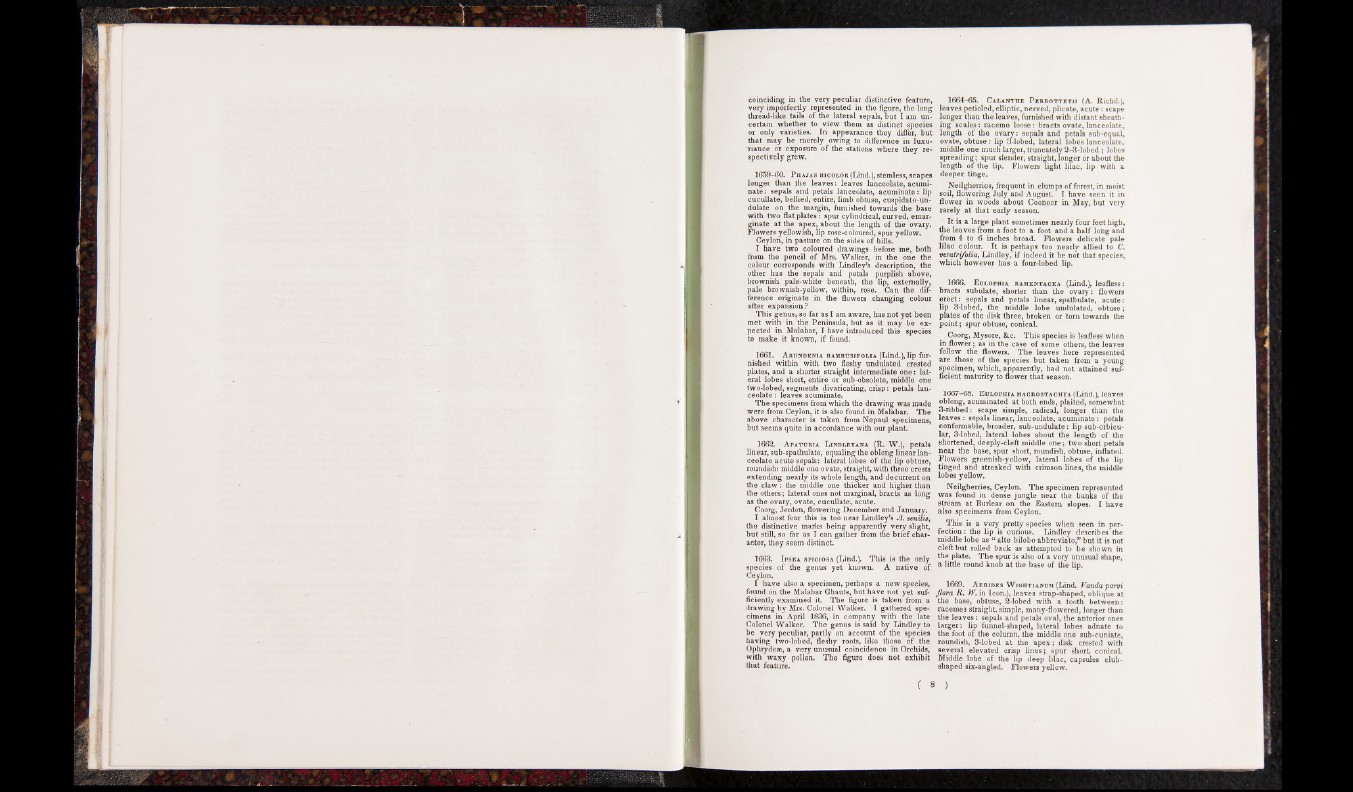
coinciding in the very peculiar distinctive feature,
very imperfectly represented in the figure, the long
thread-like tails of the lateral sepals, but I am uncertain
whether to view them as distinct species
or only varieties. In appearance they differ, but
that may be merely owing to difference in luxurian
c e or exposure of the stations where they respectively
grew.
1659-60. Phajas bicolor (Lind.), stemless, scapes
longer than the leaves: leaves lanceolate, acuminate:
sepals and petals lanceolate, acuminate : lip
cucullate, bellied, entire, limb obtuse, cuspidato-un-
dulate on the margin, furnished towards the base
with two flat plates: spur cylindrical, curved, emar-
ginate at the apex, about the length of the ovary.
Flowers yellowish, lip rose-coloured, spur yellow.
Ceylon, in pasture on the sides of bills.
I have two coloured drawings before me, both
from the pencil of Mrs. Walker, in the one the
colour corresponds with Lindley’s description, the
other has the sepals and petals purplish above,
brownish pale-white beneath, the lip, externally,
pale brownish-yellow, within, rose. Can the difference
originate in the flowers changing colour
after expansion?
This genus, so far as I am aware, has not yet been
met with in the Peninsula, but as it may be expected
in Malabar, I have introduced this species
to make it known, if found.
1661. Arundenia bambusifolia (Lind.), lip furnished
within with two fleshy undulated crested
plates, and a shorter straight intermediate one: lateral
lobes short, entire or sub-obsolete, middle one
two-lob ed, segments divaricating, crisp: petals lanceolate
: leaves acuminate.
The specimens from which the drawing was made
were from Ceylon, it is also found in Malabar. The
above character is taken from Nepaul specimens,
but seems quite in accordance with our plant.
1662. Apaturia Lindleyana (R. W.), petals
linear, sub-spathulate, equaling the oblong linear lanceolate
acute sepals: lateral lobes of the lip obtuse,
roundish: middle one ovate, straight, with three crests
extending nearly its whole length, and decurrent on
the claw: the middle one thicker and higher than
the others; lateral ones not marginal, bracts as long
as the ovary, ovate, cucullate, acute.
Coorg, Jerdon, flowering December and January.
I almost fear this is too near Lindley’s A. senilis,
the distinctive marks being apparently very slight,
but still, so far as I can gather from the brief character,
they seem distinct
1663. Ipsea spiciosa (Lind.). This is the only
species of the genus yet known. .A native of
Ceylon.
I have also a specimen, perhaps a new species,
found on the Malabar Ghauts, but have not yet sufficiently
examined it. The figure is taken from a
drawing by Mrs. Colonel Walker. I gathered specimens
in April 1836, in company with the late
Colonel Walker. The genus is said by Lindley to
be very peculiar, partly on account of the species
having two-lobed, fleshy roots, like those of the
Ophrydeas, a very unusual coincidence in Orchids,
with waxy pollen. The figure does not exhibit
that feature.
1664-65. Calanthe Perrottetii (A. Richd.),
leaves petioled, elliptic, nerved, plicate, acute: scape
longer than the leaves, furnished with distant sheathing
scales: raceme loose: bracts ovate, lanceolate,
length of the ovary: sepals and petals sub-equal,
ovate, obtuse: lip 3-lobed, lateral lobes lanceolate,
middle one much larger, truncately 2-3-lobed; lobes
spreading; spur slender, straight, longer or about the
length of the lip. Flowers light lilac, lip with a
deeper tinge.
Neilgherries, frequent in clumps of forest, in moist
soil, flowering July and August. I have seen it in
flower in woods about Coonoor in May, but very
rarely at that early season.
It is a large plant sometimes nearly four feet high,
the leaves from a foot to a foot and a half long and
from 4 to 6 inches broad. Flowers delicate pale
lilac colour. It is perhaps too nearly allied to C.
veratrifolia, Lindley, if indeed it be not that species,
which however has-a four-lobed lip.
1666. Edlophia ramentacea (Lind.), leafless:
bracts subulate, shorter than the ovary: flowers
ere c t: sepals and petals linear, spathulate, acute:
lip 3-lobed, the middle lobe undulated, obtuse;
plates of the disk three, broken or tom towards the
point; spur obtuse, conical.
Coorg, Mysore, &c. This species is leafless when
in flower; as in the case of some others, the leaves
follow the flowers. The leaves here represented
are those of the species but taken from a young
specimen, which, apparently, had not attained sufficient
maturity to flower that season.
1667-68. Eulophia macrostachya (Lind.), leaves
oblong, acuminated at both ends, plaited, somewhat
3-ribbed: scape simple, radical, longer than the
leaves: sepals linear, lanceolate, acuminate: petals
conformable, broader, sub-undulate: lip sub-orbicular,
3-lobed, lateral lobes about the length of the
shortened, deeply-cleft middle one; two snort petals
near the base, spur short, roundish, obtuse, inflated.
Flowers greenish-yellow, lateral lobes of the lip
tinged and streaked with crimson lines, the middle
lobes yellow.
Neilgherries, Ceylon. The specimen represented
was found in dense jungle near the banks of the
stream at Burlear on the Eastern slopes. I have
also specimens from Ceylon.
This is a very pretty species when seen in perfection:
the lip is curious. Lindley describes the
middle lobe as “ alte bilobo abbreviate,” but it is not
cleft but rolled back as attempted to be shown in
the plate. The spur is also of a very unusual shape,
a little round knob at the base of the lip.
1669. Ae rides Wightianum (Lind. Vanda parvi
flora R. W. in Icon.), .leaves strap-shaped, oblique at
the base, obtuse, 2-lobed with a tooth between:
racemes straight, simple, many-flowered, longer than
the leaves: sepals and petals oval, the anterior ones
larger: lip funnel-shaped, lateral lobes adnate to
the foot of the column, the middle one sub-cuniate,
roundish, 3-lobed at the ap ex ; disk crested with
several elevated crisp lines; spur short, conical.
Middle lobe of the lip deep lilac, capsules club-
shaped six-angled. Flowers yellow.